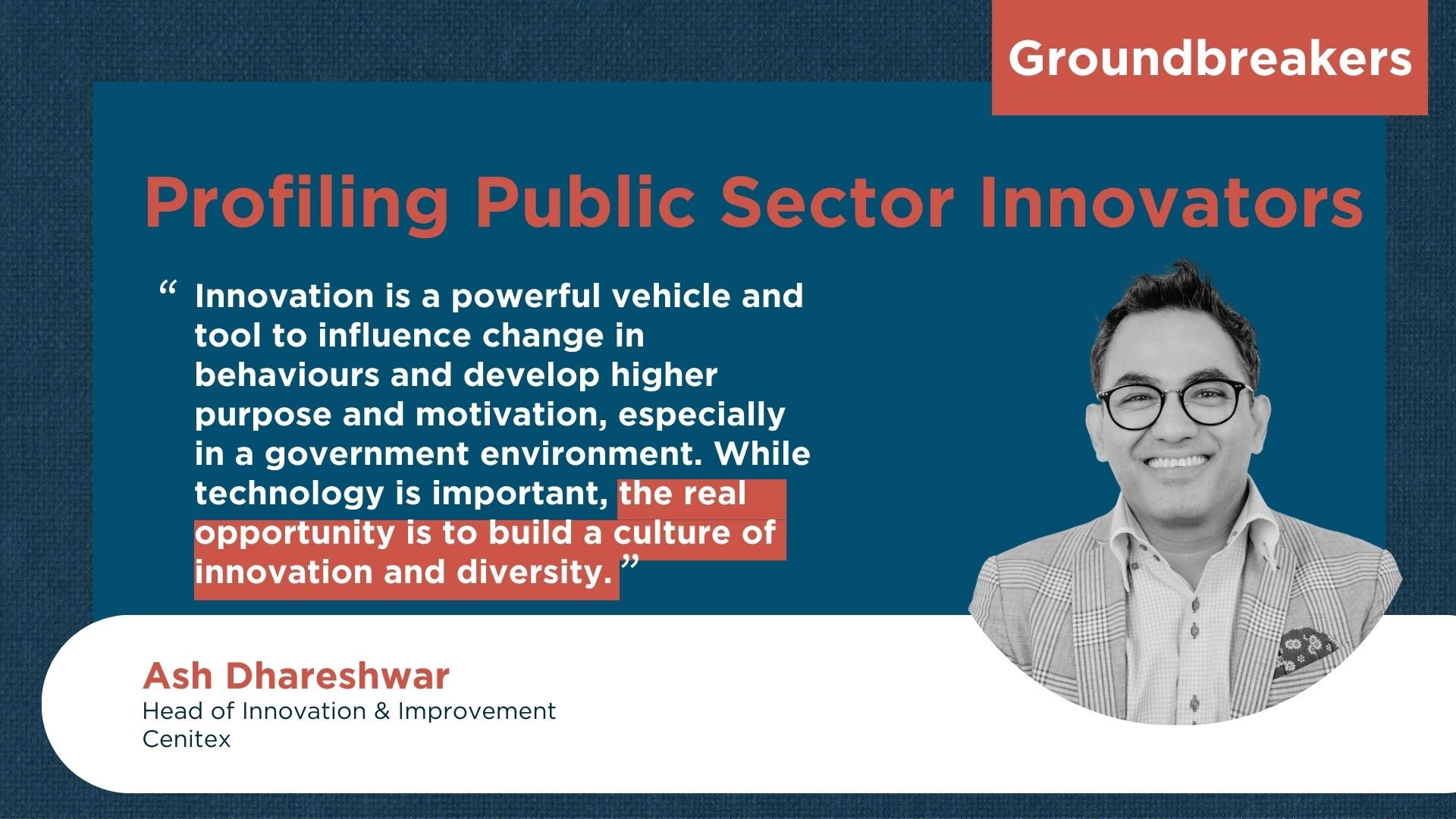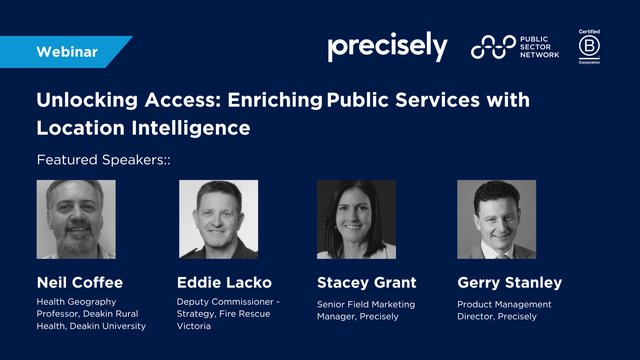

Ash Dhareshwar, the Head of Innovation & Improvement at Cenitex, is the driving force of innovation-as-usual at Cenitex and its ecosystem. Cenitex is a state-owned enterprise founded in July 2008, and its purpose is to be the Victorian Government’s trusted IT partner providing contemporary and effective services through acknowledged specialists.
Ash leads the direction in creating a safe space for sharing knowledge, ideas and innovative collaboration across its ecosystem of customers, suppliers, partners and communities. Over the past four years, Ash has launched a series of impactful initiatives with a primary focus on enhancing innovation culture. With a unique perspective gained from outside the public sector, Ash has successfully fostered a collaborative and innovative work environment.
PSN sat down with Ash to understand how the vehicle of innovation and building strong partnerships in the ecosystem fosters stronger connections to create technological advancements, and how this can be accomplished in a public sector environment.
Jordan Mullins, Head of Editorial, Public Sector Network: Ash, describe your current focus at Cenitex.
Ash Dhareshwar, Head of Innovation and Improvement, Cenitex: I've been the Head of Innovation and Improvement at Cenitex for four years now, and my focus is two-fold. Firstly, there is an internal focus on improving the organisation and its effectiveness in how we work with each other, our customers and innovation ecosystem to deliver better service outcomes for the sector. The second focus is on innovation and improving adoption of new and emerging technologies to prepare the organisation and our customers for next three to five years.
Innovation is a powerful vehicle and tool to influence change in behaviours and develop higher purpose and motivation, especially in a government environment. While technology is important, the real opportunity is to build a culture of innovation and diversity.
By placing culture front and centre, we’ve seen a huge energy increase across all teams. Further we also observed a 27% increase in our innovation culture over two-years and many of our employee engagement statistics have trended upwards. This was achieved through a series of strategic initiatives that encouraged ingenuity and innovation as a key culture trait.
JM: What challenges do you own at Cenitex?
AD: One of the biggest challenges - and opportunities - across any public or private sector organisation is to elevate the way its people and ecosystems connect and work with each other. At Cenitex my primary role is to do exactly that. I am continually improving the organisation to operate effectively and efficiently with customers and the ecosystem of suppliers, partners and communities we serve across the Victorian Public Sector.
Then the secondary challenge statement is ensuring that we, as a collective ecosystem, create a rapid way to test new and emerging technology safely and securely and enable its adoption.
JM: And how are you solving these two challenges?
AD: Before solving these challenges, it was critical to assess the operating environment state and define an iterative plan. The first two years was spent establishing effective working practices that needed focus. While we did some process improvement work, triggering a mindset shift was the key. You can’t centralise improvements. Instead, by opening mindsets to improvement you can enable everyone to act. Quickly we saw an increase in initiatives and a healthy competition to share and improve now ripples through Cenitex.
Whenever we start a new initiative, I advocate that we don’t want nominations, I want people to self-nominate to take part in initiatives. Very recently we ran a hackathon, involving twenty-two government organisations with over 100 people participating, playing different roles. This was the third yearly hackathon, and it was all through self-nomination.
Having managers nominate, forces people to join. This kills any sense of innovation I’m trying to kindle. I believe humans are innately innovative, but we tend to hide that part of ourselves at work because we’re encumbered by process. So how can we make this a mainstream conversation?
At Cenitex, one of the things we did was choose a simple 3 step framework called MAP to navigate into today’s working environment and innovate and improve everyday “innovation-as-usual.” This came back to the philosophy that the technology landscape is always changing, so if you want to be innovative everyday then innovation as usual needs to be baked into our operations and how we turn up to work.
Now as we’re creating an ecosystem of innovation and partnering with purpose, it’s also about the people. Innovation isn’t about the technology as I always maintain!
JM: How do you bake innovation into business as usual?
AD: Amongst many initiatives, primarily we’ve set up an innovation hub as a central focal point and just celebrated its one-year anniversary. With over 200 people coming through, we have had countless new connections and opportunities surfaced. Yes again, it wasn’t all about technology, right? The magic sauce is the collaboration that happens with our people and our partners. To accomplish this, innovation as usual has three ways of unifying people.
Firstly, we host innovation boosters to create a safe space to fail fast, test things and connect things to create more diverse solutions. Monthly, we also host an Innovation Talks show – where sharing is the goal!
Secondly, we get the whole organisation involved. As an example, one of our yearly innovation booster events is called Cenitex Connect. It’s a knowledge sharing and innovation exhibition. We transform our office floors into an exhibition where teams cross pollinate ideas, share wins and key project updates, featuring showcases from both within Cenitex and industry leaders. People return to their day jobs, after the event with rekindled energy, ideas and many new opportunities.
The third focus is external collaboration. Academics, enterprise and network partners – how do we work together under a unified vision? At our hackathons we have partnership involvement. Our most recent SparkVision hackathon had coaches from across Government Departments, and judges from Melbourne Business School - Chief Engagement Officer, Executive Directors from Melbourne Connect, Cenitex and DJCS - Emergency Management - Technology and Data.
When you strengthen your partnerships and actively participate in each other's initiatives, you can effectively leverage the benefits of this ecosystem.
JM: How do you leverage this new ecosystem you're describing for transformation?
AD: When you want to leverage an ecosystem, what you’re doing is creating new value.
What’s important here is that you’re utilising the existing network and finding like-minded people who want to partner and want to break new ground. This is your innovation ecosystem!
To leverage our ecosystem, we have established an Innovation lab. The purpose of the lab is to create a safe zone for innovation. The Lab rollout began last year starting with Generative AI lab and is testing multiple use cases in a safe and secure manner. The Lab is adding capabilities such as immersive experiences, secure network and IoT (Internet of Things). Supported by partnership with universities, industry leaders and other labs. So, lots in-progress.
JM: How are you measuring success, and does this differ according to who you're working with?
AD: Our success metrics don’t differ based on who we're working with. Our approach is consistent and focuses on cultural development, people metrics, process improvements, and the impact of our Innovation lab initiatives. We focus on year-on-year improvements in our culture stats. We closely analyse our people-data to gauge progress. We measure success through the activities in our Innovation Hub in Melbourne. We track the outcomes of customers and partner interactions, assessing their implementation impact and valuable lessons. Although we’ve recently reduced process measurement, we have undertaken various process automation and improvement initiatives in previous years.
JM: For my last question, what advice would you give to an organisation looking to replicate what you’re doing?
AD: Firstly, assess and understand hot spots of areas of improvement you need to bring. This is a key as every organisation is different.
Look at the way people are turning up to work. Understand how much process improvement is too much. Define an innovation strategy and stay persistent.
Driving a culture change is the key. People are the magic sauce and culture is the key to operating effectively.

































